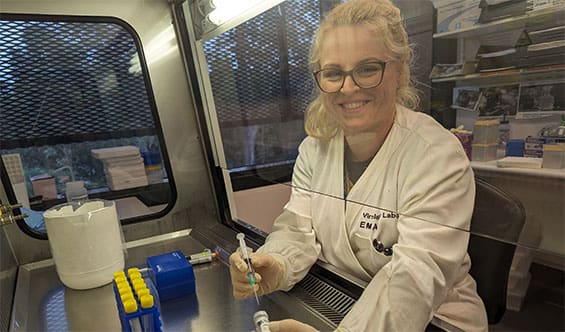
NSW DPI scientist Blaine Farrugia evaluates emergency animal disease vaccines at the Elizabeth Macarthur Agricultural Institute. Credit – John Webster, NSW DPI.
AN mRNA vaccine for Border Disease in sheep and goats has been manufactured for the first time in New South Wales, in an initiative expected to boost Australia’s preparedness for emergency animal disease incursions.
The manufacture of the congenital virus disease was fast-tracked in a New South Wales Government pilot project as part of a plan to boost biosecurity across the state.
BD virus is a pestivirus is closely related to classical Swine Fever virus and bovine virus diarrhoea virus (BVDV) and is known as hairy shaker disease in Australia and New Zealand. The NSW Department of Primary Industries said Border Disease infection of naïve, pregnant ewes can lead to placentitis, foetal death, and abortion.
Affected BD lambs are born 2-3 days prematurely and many die before or at weaning. Surviving ‘hairy shaker’ sheep remain infected and excrete the virus throughout their lives, NSW DPI said.
The department said the BDV vaccine was manufactured in Sydney by the UNSW RNA Institute after first being developed by US-based biotechnology leader, Tiba Biotech, with input from the Canadian Food Inspection Agency, the Queensland Department of Agriculture and Fisheries, Meat & Livestock Australia and the NSW RNA Pilot Facility.
While BDV is not an emergency animal disease, the learnings from this successful pilot project are now being applied to the development of vaccines for Lumpy Skin Disease and Foot-and-Mouth Disease, from which Australia remains free, NSW DPI said. The vaccine project team is now investigating whether protective antigens, identified by the CFIA, work against LSD.
All work with live viruses is being conducted overseas, while NSW DPI scientists at the Elizabeth Macarthur Agricultural Institute work on establishing the immune response, demonstrating animal safety and optimising the formulation and dose. Work so far indicates that the test LSD mRNA vaccine is quickly metabolised and cleared from the animal.
Minister for Agriculture, Regional and Western NSW, Tara Moriarty said developing local capacity to produce vaccines against emergency animal diseases is a critical priority for Australian agricultural industries and the economy.
“Now we have success with a virus which exists in Australia, we are working to establish a vaccine pipeline for priority animal diseases, including Lumpy Skin Disease and Foot-and-Mouth Disease, to ensure Australia can manufacture vaccines during an emergency response.
“Alongside a range of other biosecurity measures such as the establishment of an Independent Biosecurity Commissioner, the NRC Review and a $10 million Good Neighbour Program to clamp down on pests and weeds, the government continues to prioritise biosecurity and safeguard the future of NSW primary industries,” she said.
Economic costs of a large multi-state outbreak of FMD alone have been estimated at more than $80 billion over 10 years Australia-wide, which is why the NSW Government is working with state, territory and national governments and animal industries to safeguard livestock from these key biosecurity threats, the department said.

HAVE YOUR SAY